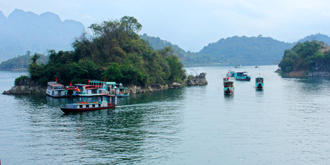
(HBO) – Ngoi Hoa Bay, where green stony islands float on the clear greenish blue water under the sunny sky, is a popular tourist destination in Ngoi Hoa commune, Tan Lac district, Hoa Binh.
The commune is also blessed with Hoa Tien Cavern, which is sure to amaze
visitors with countless glistening stalactites and stalagmites in thousands
different forms.
About 1km to the east of Hoa Tien Cavern is a
large crystal-blue water lake which is called by the locals "Tien Tam Lake”,
meaning the lake where fairies bathe. After work, many young girls often go
down there together for a bathe, and you can hear them giggling while getting
relaxed in the water just like the fairies in fairy tales.
To get to the cavern, you will have to cruise
through Hoa Binh Lake where you can enjoy a magnificent view of surrounding
mountains and forests. You can also visit Thac Bo Cavern and Bung Cave, known
as local archaeological relics.
Ngoi Hoa commune is home to about 80 families of
Muong ethnic minority group whose ancestors struggled to make ends meet hundred
years ago by picking, hunting and farming on mountainsides year round.
Today, the people make their living out of
aquaculture, forestry and tourism that provide them better living standards.
They make use of the land surrounding the bay to grow acacia and bamboo trees,
alongside melons, papaya, bananas, gourds and orchids. There are about 300
species of orchids in the Hoa Binh Lake and Ngoi Hoa Bay areas. Local people
have also built dozens of stilt houses to serve visitors.
Visitors here are always well treated with
traditional foods and drinks, which are so tasty and special, like "com lam”
(rice cooked in bamboo tubes), "xoi do trung kien” (sticky rice with ant eggs),
"nhong ong” (bee larvae), "trau nau la lom” (buffalo meat cooked with "lom”
leaves), "ca nuong nau mang chua” (grilled fish with bamboo shoots) and more.
In addition, the visitors can enjoy local folk
cultural performances, including playing of special traditional instruments and
dances.
A diverse chain of eco-tourism and resort destinations concentrated in Hoa Binh city and the districts of Tan Lac, Da Bac, and Luong Son… Along with the launch of several key high-quality resort tourism projects, these developments have reshaped the landscape and enhanced the appeal of Hoa Binh as a travel destination.
Boasting diverse terrain, a mild climate, and rich natural resources, Cao Phong district is increasingly asserting its place on Vietnam’s tourism map, attracting both domestic and foreign visitors. The district is renowned for its stunning landscapes, majestic mountains, a crystal-clear hydropower lake, and the unique cultural identity of local ethnic groups.
With its pristine landscapes, unique cultural heritage of Muong ethnic minority, and an expanding range of visitor experiences, Tan Lac district of Hoa Binh has fast become a captivating destination for both domestic and international tourists.
Until now, Sung village in Cao Son commune, Da Bac district remains the only Dao ethnic community in Hoa Binh province to develop a community-based tourism model. Beyond its untouched natural landscapes, cultural identity serves as the cornerstone attraction for visitors.
Alongside the diverse cultural identities of the Kinh, Muong, Tay, Thai, Dao, and Mong ethnic people, Hoa Binh province is also renowned as the "capital" of the northwestern Vietnamese cuisine, offering unique and distinctive dishes. At festivals, during Lunar New Year (Tet), or on significant family or community occasions, special dishes are prepared, leaving a lasting impression on visitors.
A Phong Linh (Yellow Tabebuia) flower garden in Thang village, Thach Yen commune, Cao Phong district is currently in full bloom, drawing a large number of visitors.


